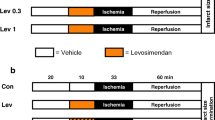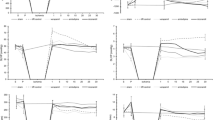Abstract.
Short episodes of ischemia (ischemic preconditioning) protect the heart against ventricular arrhythmias during zero-flow ischemia and reperfusion. However, in clinics, many episodes of ischemia present a residual flow (low-flow ischemia). Here we examined whether ischemic preconditioning protects against ventricular arrhythmias during and after a low-flow ischemia and, if so, by what mechanism(s).
Isolated rat hearts were subjected to 60 min of low-flow ischemia (12% residual coronary flow) followed by 60 min of reperfusion. Ischemic preconditioning was induced by two cycles of 5 min of zero-flow ischemia followed by 5 and 15 min of reperfusion, respectively. Arrhythmias were evaluated as numbers of ventricular premature beats (VPBs) as well as incidences of ventricular tachycardia (VT) and ventricular .brillation (VF) during low-flow ischemia and reperfusion. Ischemic preconditioning significantly reduced the number of VPBs and the incidence of VT and of VF during low-flow ischemia. This antiarrhythmic effect of preconditioning was abolished by HOE 140 (100 nM), a bradykinin B2 receptor blocker. Similar to preconditioning, exogenous bradykinin (10 nM) reduced the number of VPBs and the incidence of VT and of VF during low-flow ischemia. Furthermore, the antiarrhythmic effects of both ischemic preconditioning and bradykinin were abolished by glibenclamide (1 µM), a non-specific blocker of ATP-sensitive K+ (KATP) channels. Finally, the antiarrhythmic effects of both ischemic preconditioning and bradykinin were abolished by HMR 1098 (10 µM), a sarcolemmal KATP channel blocker but not by 5-hydroxydecanoate (100 µM), a mitochondrial KATP channel blocker. In conclusion, ischemic preconditioning protects against ventricular arrhythmias induced by low-flow ischemia, and this protection involves activation of bradykinin B2 receptors and subsequent opening of sarcolemmal but not of mitochondrial KATP channels.
Similar content being viewed by others
Author information
Authors and Affiliations
Corresponding author
Rights and permissions
About this article
Cite this article
Driamov, S., Bellahcene, M., Ziegler, A. et al. Antiarrhythmic effect of ischemic preconditioning during low-flow ischemia. Basic Res Cardiol 99, 299–308 (2004). https://doi.org/10.1007/s00395-004-0468-5
Received:
Revised:
Accepted:
Published:
Issue Date:
DOI: https://doi.org/10.1007/s00395-004-0468-5




